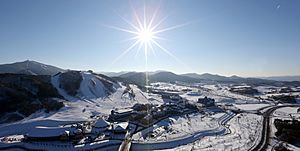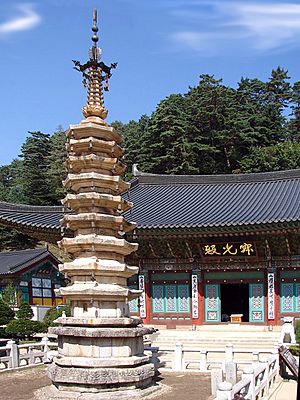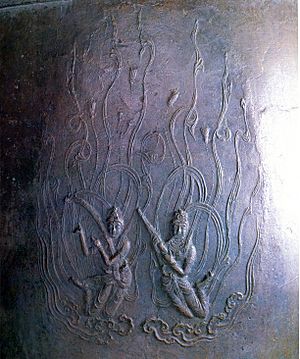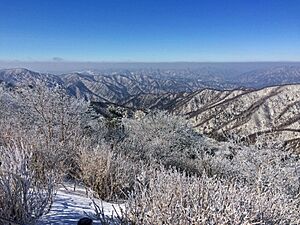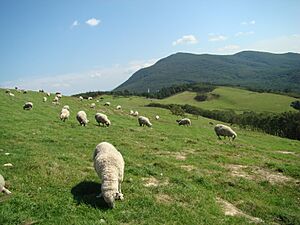Pyeongchang facts for kids
Quick facts for kids
Pyeongchang
평창군
|
||
|---|---|---|
|
County
|
||
| Korean transcription(s) | ||
| • Hangul | 평창군 | |
| • Hanja | 平昌郡 | |
| • Revised Romanization | Pyeongchang-gun | |
| • McCune-Reischauer | P'yŏngch'ang-gun | |
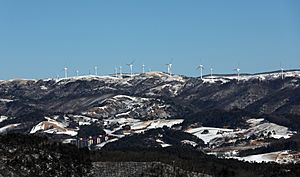
Alpensia Resort and a wind farm in Pyeongchang
|
||
|
||
| Etymology: 平 "peaceful" or "flatland", 昌 "prosperity" or "flourishing" | ||
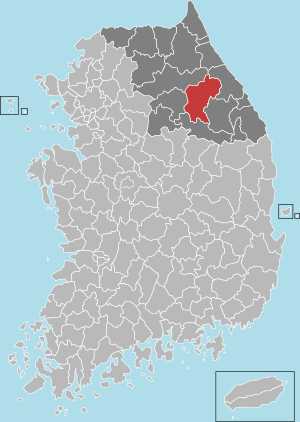
Location in Gangwon Province, South Korea
|
||
| Country | South Korea | |
| Province | Gangwon-do | |
| Administrative divisions | 1 eup, 7 myeon | |
| Area | ||
| • Total | 1,463.65 km2 (565.12 sq mi) | |
| Population | ||
| • Total | 43,666 | |
| • Density | 30/km2 (80/sq mi) | |
| • Dialect | Gangwon | |
| Time zone | UTC+9 | |
Pyeongchang is a county in Gangwon-do province, South Korea. It is located in the Taebaek Mountains region. Many old Buddhist temples, like Woljeongsa, are found here. Pyeongchang is about 180 km (112 mi) east of Seoul, the capital of South Korea. You can reach it by expressways and high-speed trains.
Pyeongchang's slogan is "Happy 700 Pyeongchang." This comes from its average elevation of about 700 meters (2,300 ft) above sea level. Pyeongchang hosted the 2018 Winter Olympics and the 2018 Winter Paralympics. For these games, its name was officially spelled "PyeongChang" (with a capital 'C'). This was done to avoid confusion with Pyongyang in North Korea.
Contents
A Look at Pyeongchang's Past
The Pyeongchang area was once part of the Goguryeo Dynasty during the Three Kingdoms of Korea period. It was known as Uk-o-hyeon back then. Later, after the Silla dynasty took over, it was renamed Baek-o-hyeon.
When the Goryeo Dynasty began, the area was called Pyeongchang-hyeon. It was controlled by Wonju. In 1299, Pyeongchang became independent from Wonju.
In 1392, the Joseon Dynasty was founded. The area was then made into a county (gun). It became part of Gangwon-do.
Exploring Pyeongchang's Geography
Pyeongchang is very mountainous. About 84% of its land is covered by mountains. The average height of these mountains is 750 meters (2,460 ft).
The most famous part of Pyeongchang is Daegwallyeong-myeon. This area is usually between 700 and 800 meters (2,300–2,600 ft) above sea level. Some spots are even higher than 1,000 meters (3,300 ft).
Pyeongchang's Climate
Pyeongchang County has a humid continental climate. This means it has warm summers. The winters in Pyeongchang are long and get a lot of snow. Summers are quite short.
From 2001 to 2010, the average temperature in Pyeongchang was 7.0 °C (44.6 °F). This was lower than the average for all of Gangwon. The area also gets a lot of rain. From 2001 to 2010, the yearly precipitation was 1,555.0 mm (61.22 in). This was more than the average for Gangwon.
The warmest months are July and August. The coldest months are January and February.
| Climate data for Daegwallyeong, Pyeongchang (1981–2010, extremes 1971–present) | |||||||||||||
|---|---|---|---|---|---|---|---|---|---|---|---|---|---|
| Month | Jan | Feb | Mar | Apr | May | Jun | Jul | Aug | Sep | Oct | Nov | Dec | Year |
| Record high °C (°F) | 8.7 (47.7) |
16.5 (61.7) |
19.7 (67.5) |
30.1 (86.2) |
31.0 (87.8) |
32.3 (90.1) |
32.9 (91.2) |
32.7 (90.9) |
29.0 (84.2) |
24.7 (76.5) |
21.5 (70.7) |
13.5 (56.3) |
32.9 (91.2) |
| Mean daily maximum °C (°F) | −2.5 (27.5) |
−0.4 (31.3) |
4.4 (39.9) |
12.9 (55.2) |
17.6 (63.7) |
20.5 (68.9) |
22.8 (73.0) |
22.8 (73.0) |
18.6 (65.5) |
14.0 (57.2) |
7.0 (44.6) |
0.5 (32.9) |
11.5 (52.7) |
| Daily mean °C (°F) | −7.7 (18.1) |
−5.5 (22.1) |
−0.5 (31.1) |
7.0 (44.6) |
11.9 (53.4) |
15.7 (60.3) |
19.1 (66.4) |
19.1 (66.4) |
14.1 (57.4) |
8.3 (46.9) |
1.3 (34.3) |
−4.4 (24.1) |
6.6 (43.9) |
| Mean daily minimum °C (°F) | −12.6 (9.3) |
−10.5 (13.1) |
−5.2 (22.6) |
1.2 (34.2) |
6.3 (43.3) |
11.2 (52.2) |
16.0 (60.8) |
16.1 (61.0) |
10.0 (50.0) |
3.1 (37.6) |
−2.8 (27.0) |
−9.1 (15.6) |
2.0 (35.6) |
| Record low °C (°F) | −28.9 (−20.0) |
−27.6 (−17.7) |
−23.0 (−9.4) |
−14.6 (5.7) |
−4.7 (23.5) |
−1.7 (28.9) |
4.4 (39.9) |
3.3 (37.9) |
−2.3 (27.9) |
−9.9 (14.2) |
−18.7 (−1.7) |
−24.7 (−12.5) |
−28.9 (−20.0) |
| Average precipitation mm (inches) | 62.6 (2.46) |
53.6 (2.11) |
75.6 (2.98) |
89.5 (3.52) |
122.3 (4.81) |
201.0 (7.91) |
326.7 (12.86) |
420.9 (16.57) |
307.3 (12.10) |
124.9 (4.92) |
76.9 (3.03) |
36.8 (1.45) |
1,898 (74.72) |
| Average precipitation days (≥ 0.1 mm) | 10.5 | 10.5 | 11.3 | 9.5 | 11.1 | 13.2 | 17.6 | 17.8 | 13.0 | 8.7 | 10.1 | 9.4 | 142.7 |
| Average snowy days | 13.0 | 11.8 | 12.0 | 3.3 | 0.2 | 0.0 | 0.0 | 0.0 | 0.0 | 0.8 | 5.2 | 10.9 | 57.2 |
| Average relative humidity (%) | 67.3 | 67.0 | 67.5 | 61.0 | 68.4 | 79.2 | 85.7 | 87.0 | 84.6 | 75.2 | 69.9 | 67.3 | 73.3 |
| Mean monthly sunshine hours | 197.2 | 185.2 | 202.3 | 226.6 | 229.4 | 179.8 | 138.1 | 130.7 | 143.9 | 193.3 | 176.4 | 191.9 | 2,194.8 |
| Percent possible sunshine | 64.4 | 60.8 | 54.6 | 57.4 | 52.1 | 40.7 | 30.8 | 31.0 | 38.6 | 55.5 | 57.8 | 64.3 | 49.3 |
| Source: Korea Meteorological Administration (percent sunshine and snowy days) | |||||||||||||
Culture and Fun in Pyeongchang
Important Cultural Sites
Pyeongchang has many important cultural sites. The South Korean government has listed 16 of them. The Gangwon Provincial Office has listed 45 more.
These sites include:
- 5 National Treasures
- 5 Treasures
- 1 Historic Site
- 3 Natural Monuments
- Many other cultural items and materials
Ancient Temples
Sangwonsa is a temple on Odaesan Mountain. It was first built in 705. Even when the Joseon Dynasty did not support Buddhism, they still helped rebuild this temple. In 1401, King Taejong helped build a part of it. Later, King Sejo and his helpers also helped rebuild the temple in 1465. Sejo's son, King Yejong, made it a special place to remember his father.
Sangwonsa holds several important cultural items:
- The Bell of Sangwonsa (National Treasure No. 36)
- A wooden statue of the Manjusri Child (National Treasure No. 221)
Woljeongsa is another temple on Odaesan Mountain. Monk Jajang built it in 643. The temple was rebuilt many times over the years. During a battle in 1951, 10 of its buildings were burned down. Later, monks worked to rebuild the temple.
Woljeongsa also has important cultural items:
- The Octagonal Nine-story Stone Pagoda of Woljeongsa (National Treasure No. 48-1)
- A stone statue of the Bodhisattva (National Treasure No. 48-2)
Historic Places
The Pyeongchang Odaesan Historic Archive (Historic Site No. 37) is a special place. It was one of five places where important historical records were kept. These records include the Annals of the Joseon Dynasty.
Fun Festivals
- Daegwallyeong Snow Festival: This festival started in 1992. It includes fun winter activities like skiing races, building snowmen, and sledding. They also have traditional games and a snow car race. In 2018, the festival was held before the Winter Olympics. It featured snow figures, a snow sledge competition, and traditional folk shows.
- Hyoseok Cultural Festival: This festival celebrates Lee Hyo-seok, a famous Korean writer. It takes place in Lee Hyo-seok Culture Village, where he grew up.
Interesting Museums
- Lee Seung-bok Memorial Hall: This hall is in Nodong-ri. It remembers Lee Seung-bok, a young boy who died in 1968. The hall was built in 1982. Lee's old house was also restored in 2000.
Great Places to Visit
Odaesan Mountain is home to the old Buddhist temples Sangwonsa and Woljeongsa. It became a national park in 1975. Its highest point, Birobong Peak, is 1,563 meters (5,128 ft) high.
Pyeongchang has two main ski resorts. They were used for the 2018 Winter Olympics.
- Alpensia ski resort has six slopes for skiing and snowboarding. Some runs are up to 1,400 meters (4,600 ft) long. It has areas for beginners and advanced skiers. Alpensia hosted most of the Olympic snow events.
- Yongpyong Resort has 28 ski slopes. It hosted the technical alpine skiing events during the Olympics.
Alpensia also has a new concert hall and an indoor water park. It was a main spot for the 2018 Cultural Olympiad.
Samyang Ranch is the biggest highland farm in Asia. It is located in the hills of Daegwallyeong. It is like a petting zoo and has beautiful views. The ranch is run by Samyang food, a company famous for bringing instant noodles to Korea. This ranch was also a filming location for the drama Autumn in My Heart and the movie Lover’s Concerto.
Images for kids
See also
 In Spanish: Pieonchang para niños
In Spanish: Pieonchang para niños



